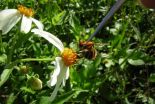(Press-News.org) NEWPORT, Ore. – Pilot whales that have died in mass strandings in New Zealand and Australia included many unrelated individuals at each event, a new study concludes, challenging a popular assumption that whales follow each other onto the beach and to almost certain death because of familial ties.
Using genetic samples from individuals in large strandings, scientists have determined that both related and unrelated individuals were scattered along the beaches – and that the bodies of mothers and young calves were often separated by large distances.
Results of the study are being published this week in the Journal of Heredity.
Scott Baker, associate director of the Marine Mammal Institute at Oregon State University, said genetic identification showed that, in many cases, the mothers of calves were missing entirely from groups of whales that died in the stranding. This separation of mothers and calves suggests that strong kinship bonds are being disrupted prior to the actual stranding – potentially playing a role in causing the event.
"Observations of unusual social behavior by groups of whales prior to stranding support this explanation," said Baker, who frequently advises the International Whaling Commission and is co-author of the Journal of Heredity article. The OSU cetacean expert is a professor in the Department of Fisheries and Wildlife at the university's Hatfield Marine Science Center in Newport, Ore.
The mass stranding of pilot whales is common in New Zealand and Australia, involving several thousand deaths over the last few decades, according to Marc Oremus of the University of Auckland, who is lead author on the study. The researchers say their genetic analysis of 490 individual pilot whales from 12 different stranding events showed multiple maternal lineages among the victims in each stranding, and thus no correlation between kinship and the grouping of whales on the beach.
This challenges another popular hypothesis – that "care-giving behavior" directed at close maternal relatives may be responsible for the stranding of otherwise healthy whales, Oremus said.
"If kinship-based behavior was playing a causal role in strandings, we would expect that whales in a stranding event would be related to one another through descent from a common maternal ancestor, such as a grandmother or great-grandmother – and that close kin would be clustered on the beach," Oremus said. "Neither of these was the case."
Because of the separation of mothers and calves, or in some cases, the outright absence of mothers among the victims, the study has important implications for agencies and volunteers who work to save the stranded whales, Baker said.
"Rescue efforts aimed at 'refloating' stranded whales often focus on placing stranded calves with the nearest mature females, on the assumption that the closest adult female is the mother," Baker pointed out. "Our results suggest that rescuers should be cautious when making difficult welfare decisions – such as the choice to rescue or euthanize a calf – based on this assumption alone."
Long-finned pilot whales are the most common species to strand en masse worldwide, the researchers noted, and most of their beaching events are thought to be unrelated to human activity – unlike strandings of some other species. Both naval sonar and the noise of seismic exploration have been linked to the stranding of other species.
The phenomenon is not new. In fact, mass strandings of whales or dolphins were described by Aristotle more than 2,000 years ago and were thought to have some kind of natural cause, Baker said, although it is unclear what that may be.
"It is usually assumed that environmental factors, such as weather or the pursuit of prey, brings pilot whales into shallow water where they become disoriented," Baker said. "Our results suggest that some form of social disruption also contributes to the tendency to strand."
"It could be mating interaction or competition with other pods of whales," Baker said. "We just don't know. But it is certainly something that warrants further investigation."
The researchers hope their study will lead to better genetic sampling of more pilot whales and other stranded whale species, as well as the use of satellite tags to monitor the survival and behavior of whales that are helped back into the ocean.
"The causal mechanisms of these strandings remain an enigma," Oremus said, "so the more avenues of research we can pursue before and after the whales beach themselves, the more likely we are to discover why it happens."
### The study was funded by the Marsden Fund of the Royal Society of New Zealand and the Australian Marine Mammal Centre, with support from the New Zealand Department of Conservation and the Australian Department of Primary Industries, Parks, Water and Environment. Baker's work is supported by a Pew Marine Conservation Fellowship for the study of dolphins around islands of the South Pacific.
Note to Editors: The journal article should be posted on March 14 by the Oxford University Press at: http://bit.ly/10ixRmF. A photo of a mass stranding of pilot whales is available at the link below:
Pilot whales: http://www.flickr.com/photos/oregonstateuniversity/8539319891/in/photostream
PHILADELPHIA - Brown fat is a hot topic, pardon the pun. Brown fats cells, as opposed to white fat cells, make heat for the body, and are thought to have evolved to help mammals cope with the cold. But, their role in generating warmth might also be applied to coping with obesity and diabetes.
The lab of Patrick Seale, PhD, at the Perelman School of Medicine, University of Pennsylvania, studies what proteins guide the development, differentiation, and function of fat cells. Seale and postdoctoral fellow Sona Rajakumari, PhD, along with Jun Wu from the Dana-Farber Cancer ...
Scientists already knew that some social bee species warn their conspecifics when detecting the presence of a predator near their hive, which in turn causes an attack response to the possible predator. Researchers at the University of Tours (France) in collaboration with the Experimental Station of Arid Zones of Almeria (Spain) have now demonstrated that they also use chemical signals to mark those flowers where they have previously been attacked.
Researchers at the University of Tours (France) and the Experimental Station of Arid Zones of Almeria (EEZA-CSIC) conducted ...
Mountain View, Calif. – March 14, 2013 – In the largest ever genome-wide association study on myopia, 23andMe, the leading personal genetics company, identified 20 new genetic associations for myopia, or nearsightedness. The company also replicated two known associations in the study, which was specific to individuals of European ancestry. The study included an analysis of genetic data and survey responses from more than 50,000 23andMe customers and demonstrates that the genetic basis of myopia is complex and affected by multiple genes.
Myopia is the most common eye ...
A new research technique, pioneered by Dr. Maria Angela Franceschini, will be published in JoVE (Journal of Visualized Experiments) on March 14th. Researchers at Massachusetts General Hospital and Harvard Medical School have developed a non-invasive optical measurement system to monitor neonatal brain activity via cerebral metabolism and blood flow.
Of the nearly four million children born in the United States each year, 12% are born preterm, 8% are born with low birth weight, and 1-2% of infants are at risk for death associated with respiratory distress. The result ...
Bangkok, 14 March 2013. CITES plenary today accepted Committee recommendations to list five species of highly traded sharks under the CITES Appendices, along with those for the listing of both manta rays and one species of sawfish. Japan, backed by Gambia and India, unsuccessfully challenged the Committee decision to list the oceanic whitetip shark, while Grenada and China failed in an attempt to reopen debate on listing three hammerhead species. Colombia, Senegal, Mexico and others took the floor to defend Committee decisions to list sharks.
"We are thrilled with this ...
BANGKOK -- March 14, 2013 -- The following statement was issued today by WCS President and CEO Cristian Samper:
The Wildlife Conservation Society (WCS) today celebrates the decision by an historic, broad group of nations from around the world to list five new sharks, freshwater sawfish, and two manta ray species for protection by the Convention on International Trade in Endangered Species of Wild Fauna and Flora (CITES). This vote is a first, critical step in working to ensure that international trade does not threaten the survival of commercially valuable shark and ray ...
The European Parliament recently voted to scrap the controversial discards policy, which has seen fishermen throwing thousands of edible fish and fish waste back into the sea because they have exceeded their quotas.
Scientists at Plymouth University believe this could have a negative impact on some seabirds, which have become used to following the fishing vessels and are increasingly reliant on their discards.
But they say others could return to using foraging as their sole source of food, as long as there are sufficient numbers of fish to meet their needs.
Dr Stephen ...
How you get the chameleon of the molecules to settle on a particular "look" has been discovered by RUB chemists led by Professor Dominik Marx. The molecule CH5+ is normally not to be described by a single rigid structure, but is dynamically flexible. By means of computer simulations, the team from the Centre for Theoretical Chemistry showed that CH5+ takes on a particular structure once you attach hydrogen molecules. "In this way, we have taken an important step towards understanding experimental vibrational spectra in the future", says Dominik Marx. The researchers report ...
A project led by scientists from Royal Holloway University in collaboration with Princeton University, has found evidence of how people form into tribe-like communities on social network sites such as Twitter.
In a paper published in EPJ Data Science, they found that these communities have a common character, occupation or interest and have developed their own distinctive languages.
"This means that by looking at the language someone uses, it is possible to predict which community he or she is likely to belong to, with up to 80% accuracy," said Dr John Bryden from ...
American bullfrogs are native to eastern North America but have been transported by people to many other parts of the globe, and other parts of North America, where they have readily established populations and become an invasive alien menace to native ecosystems. In the largest study of its kind to date, the stomach contents of over 5,000 invasive alien American bullfrogs from 60 lakes and ponds on southern Vancouver Island were examined to identify the native and exotic animals that they had preyed upon. The study was published in the open access journal NeoBiota.
Over ...



